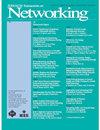重新架构无损以太网中的缓冲区管理
IF 3.6
3区 计算机科学
Q2 COMPUTER SCIENCE, HARDWARE & ARCHITECTURE
引用次数: 0
摘要
融合以太网采用基于优先级的流量控制(PFC)来提供无损网络。然而,PFC引起的问题,包括受害者流、拥塞蔓延和死锁,阻碍了它在生产系统中的大规模部署。对交换机缓冲区占用的细粒度实验观察发现,这些性能问题的根本原因是端到端拥塞控制和逐跳流控制之间的发送速率不匹配。解决这种不匹配需要交换机提供额外的缓冲区,而当前共享缓冲区商用交换机中的经典动态阈值(DT)策略不支持这一点。在本文中,我们提出了选择性pfc (SPFC),一个实用的缓冲区管理方案来处理这种不匹配。具体来说,SPFC通过主动检测端口流量并相应地调整缓冲区分配来选择性地触发PFC PAUSE帧,从而增量地修改DT。大量的案例研究表明,SPFC可以将非突发端口上的PFC暂停次数减少69.0%,并将大受害流量的平均流量完成时间减少83.5%。本文章由计算机程序翻译,如有差异,请以英文原文为准。
Re-Architecting Buffer Management in Lossless Ethernet
Converged Ethernet employs Priority-based Flow Control (PFC) to provide a lossless network. However, issues caused by PFC, including victim flow, congestion spreading, and deadlock, impede its large-scale deployment in production systems. The fine-grained experimental observations on switch buffer occupancy find that the root cause of these performance problems is a mismatch of sending rates between end-to-end congestion control and hop-by-hop flow control. Resolving this mismatch requires the switch to provide an additional buffer, which is not supported by the classic dynamic threshold (DT) policy in current shared-buffer commercial switches. In this paper, we propose Selective-PFC (SPFC), a practical buffer management scheme that handles such mismatch. Specifically, SPFC incrementally modifies DT by proactively detecting port traffic and adjusting buffer allocation accordingly to trigger PFC PAUSE frames selectively. Extensive case studies demonstrate that SPFC can reduce the number of PFC PAUSEs on non-bursty ports by up to 69.0%, and reduce the average flow completion time by up to 83.5% for large victim flows.
求助全文
通过发布文献求助,成功后即可免费获取论文全文。
去求助
来源期刊

IEEE/ACM Transactions on Networking
工程技术-电信学
CiteScore
8.20
自引率
5.40%
发文量
246
审稿时长
4-8 weeks
期刊介绍:
The IEEE/ACM Transactions on Networking’s high-level objective is to publish high-quality, original research results derived from theoretical or experimental exploration of the area of communication/computer networking, covering all sorts of information transport networks over all sorts of physical layer technologies, both wireline (all kinds of guided media: e.g., copper, optical) and wireless (e.g., radio-frequency, acoustic (e.g., underwater), infra-red), or hybrids of these. The journal welcomes applied contributions reporting on novel experiences and experiments with actual systems.
 求助内容:
求助内容: 应助结果提醒方式:
应助结果提醒方式:


